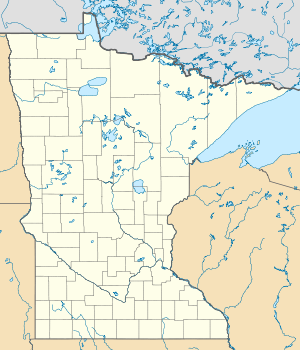Tenth Avenue Bridge
Coordinates: 44 ° 58 ′ 44 " N , 93 ° 14 ′ 38" W.
| Tenth Avenue Bridge | ||
|---|---|---|
| The Tenth Avenue Bridge in Minneapolis | ||
| use | Motor vehicle traffic (2 lanes) | |
| Crossing of | Mississippi River | |
| place | Minneapolis , Minnesota | |
| Entertained by | Minnesota Department of Transportation | |
| Building number | 2796 | |
| construction | Arched bridge made of reinforced concrete | |
| overall length | 662.9 m | |
| width | 20.7 m | |
| Longest span | 80.9 m | |
| Clear height | 33.5 m | |
| building-costs | 891,000 US dollars | |
| start of building | 1926 | |
| opening | 1929 | |
| location | ||
|
|
||
| Bridges in Minneapolis / St. Paul | ||
| Tenth Ave Bridge is drawn in green, roughly in the middle of the picture, between the I-35 bridge in dark red and Washington Ave. bridge | ||
The Tenth Avenue Bridge crosses the Mississippi River near central Minneapolis , Minnesota , very close to the University of Minnesota campus . Before the construction of the now-collapsed Interstate 35W Mississippi River Bridge, the bridge was named Cedar Avenue Bridge because it was originally connected to this road. Today it connects Tenth Avenue Southeast on the east side of the river with 19th Avenue South on the west. The bridge is considered to be the life's work of the Minneapolis city engineer Kristoffer Olsen Oustad , who was one of four prominent Norwegian architects who had a major impact in the region. The structure was added to the National Register of Historic Places in 1989 and forms the downstream boundary of the Saint Anthony Falls Historic District .
Construction of the bridge began in 1926 and was completed in 1929. The total length is 662.9 m, with the two central spans being 80.9 m. It is an arch bridge and is constructed from reinforced concrete . Higher and longer than any other bridge in the region before, it was originally 890.3 m long, 213 m longer than the nearby Third Avenue Bridge . It reaches a height of 33.5 m above the water surface. The construction costs amounted to 891,000 US dollars . A major reconstruction was carried out between 1972 and 1976 and the approach areas of the bridge were changed. These were not thought to be architecturally significant, even when the bridge was new. The southern approach was modified so that the bridge now led straight onto Washington Avenue and no longer onto Cedar Avenue.
The bridge was originally built to shift the flow of traffic over the bridges in central Minneapolis one mile further upstream. The streets in the neighborhood have been disrupted by the construction of Interstate 35W . The southern end of the lower canal lock on the Saint Anthony Falls extends under the bridge. Southeast Steam Plant , a Historic Place is close by.
The original Cedar Avenue Bridge was built in 1872, but was not in the same location, but was a little upstream, closer to the Hennepin Avenue Bridge . The construction at that time was a steel truss bridge with a 5.2 m wide road and sidewalks. After the new construction, the old bridge remained in operation until 1934 when it was closed to traffic and the sidewalks were removed. In 1942 the old structure was demolished and scrapped. The four hundred tons of metal were used for armaments purposes during World War II .
literature
- (1996). Minnesota's Historic Bridges: Cedar Avenue Bridge. Minnesota Historical Society .
- Mary Charlotte Costello: Climbing the Mississippi River Bridge by Bridge. Volume 2: Minnesota. MC Costello, Davenport IA 2002, ISBN 0-9644518-2-4 .
|
Upstream Interstate 35W Mississippi River Bridge (collapsed) St. Anthony Falls (35W) Bridge |
Crossing the Mississippi River |
Downriver Northern Pacific Bridge Number 9 |



